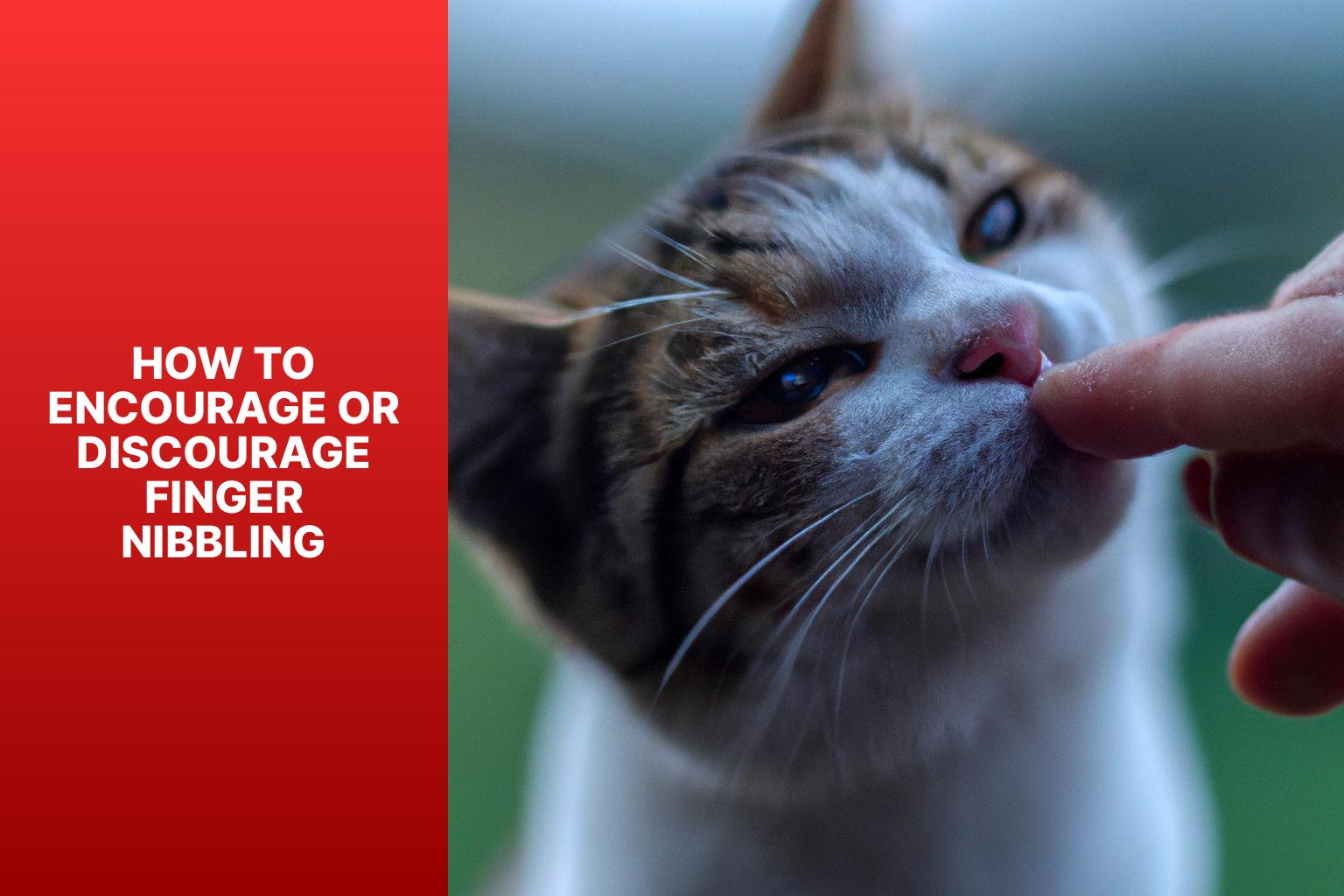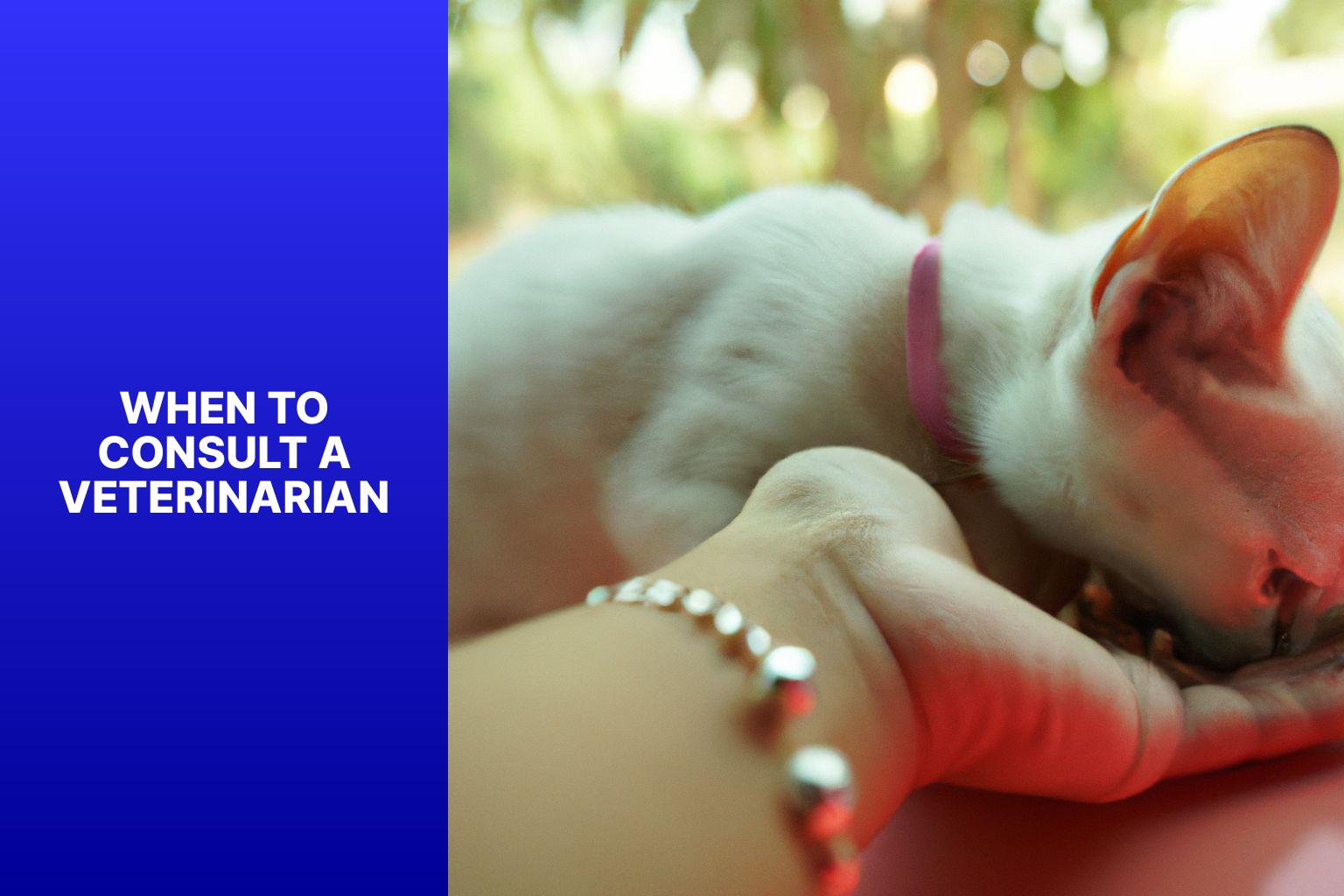Why Does My Cat Nibble on My Fingers?
Understanding cat behavior is key to deciphering their actions and habits. One common question that many cat owners have is, “Why does my cat nibble on my fingers?” This behavior may seem strange or even cute, but it’s essential to understand its underlying reasons.
Is Finger Nibbling Normal Behavior for Cats?
Before delving into the reasons behind finger nibbling, it’s important to determine whether this behavior is considered normal for cats. The answer is yes, finger nibbling can be normal behavior for cats. They may display this behavior for various reasons, ranging from affection and bonding to playfulness and exploration.
Possible Reasons for Cat Finger Nibbling
There are several possible explanations for why your cat may nibble on your fingers:
1. Affection and Bonding: Cats often use gentle nibbling as a way to show affection and create a bond with their owners.
2. Playfulness and Hunting Instinct: Nibbling can be a playful behavior for cats, simulating their instinct to hunt and pounce.
3. Teething and Exploration: Kittens may nibble on fingers during their teething phase or as a way to explore their environment.
4. Communication and Attention-Seeking: Nibbling on fingers can be a form of communication or an attempt to seek attention from their owners.
How to Encourage or Discourage Finger Nibbling
If you find your cat’s finger nibbling behavior undesirable or excessive, there are ways to encourage or discourage it:
1. Provide Appropriate Chew Toys: Offer your cat suitable chew toys to redirect their nibbling behavior onto more appropriate items.
2. Redirect Attention to Interactive Toys: Engage your cat with interactive toys that stimulate play and hunting instincts.
3. Use Positive Reinforcement and Rewards: Reward your cat with treats and praise when they display appropriate behavior, such as playing with toys instead of nibbling fingers.
4. Avoid Punishment or Rough Handling: Never punish your cat for nibbling or use rough handling, as it can lead to fear or aggression.
Signs of Problematic Nibbling Behavior
While finger nibbling is generally harmless, there are signs that it may become problematic:
1. Aggression or Painful Nibbling: If your cat’s nibbling becomes aggressive or painful, it could indicate an underlying issue that requires attention.
2. Excessive Nibbling or Chewing: Excessive nibbling or chewing on fingers may lead to skin irritation or wounds and should be addressed.
3. Compulsive or Obsessive Behavior: If your cat displays compulsive or obsessive nibbling behavior, consult a veterinarian for further evaluation.
When to Consult a Veterinarian
If your cat’s finger nibbling behavior becomes concerning or problematic, it’s advisable to consult with a veterinarian. They can assess your cat’s behavior, rule out any underlying health issues, and provide guidance on managing or modifying the behavior if necessary.
By understanding the reasons behind your cat’s finger nibbling and taking appropriate steps to redirect their behavior, you can ensure a harmonious relationship with your furry friend.
Key takeaway:
- Finger nibbling is a normal behavior for cats: Understanding why your cat nibbles on your fingers can help you bond better with your feline friend.
- Possible reasons for cat finger nibbling: Cats may nibble on fingers as an expression of affection, playfulness, teething, or to seek attention and communicate.
- Encouraging or discouraging finger nibbling: Providing appropriate toys, redirecting attention, using positive reinforcement, and avoiding punishment can help manage finger nibbling behavior.
Why Does My Cat Nibble on My Fingers?
Cats naturally nibble and play with their owner’s fingers for various reasons. One of the reasons is affection. Nibbling on fingers is a sign of love and bonding from your cat.
Another reason is exploration. Cats explore their surroundings by nibbling, so they may be interested in the texture of your fingers and want to investigate.
Teething is also a reason why kittens may nibble on fingers. They do it to alleviate discomfort.
Cats may nibble on fingers as a playful behavior, especially if they associate fingers with toys or interactive play.
Sometimes, cats nibble on fingers to seek attention or express a desire to play.
True story: My playful cat Luna loves to nibble on my fingers to initiate playtime and get my attention. We have bonded through this activity, and I ensure she has appropriate toys and play sessions to fulfill her play and exploration needs.
Understanding Cat Behavior
Cats exhibit fascinating behaviors that we can observe and try to comprehend. Understanding cat behavior allows us to create a harmonious environment for our feline companions.
1. Communication: Cats communicate through body language, vocalizations, and scent marking. By understanding cat behavior, we can decipher the meanings behind their tail, ear, and whisker movements, allowing us to better comprehend their emotions.
2. Territory: Cats are territorial and mark their territory to establish boundaries. They may engage in scent marking by rubbing scent glands on objects or urinate in specific areas. Understanding cat behavior helps us recognize their need for territorial marking and provide appropriate outlets for them to do so.
3. Hunting Instincts: Cats have a natural instinct to hunt. By understanding cat behavior, we can acknowledge their innate hunting instincts and provide interactive toys that satisfy this instinct. This not only enriches their lives but also prevents destructive behavior.
4. Socialization: Cats are social animals, but their social interactions differ from dogs or humans. Understanding cat behavior allows us to recognize and respect their unique ways of socializing. By understanding their hierarchies and subtle cues, we can foster positive social interactions among cats and between cats and humans.
5. Body Language: Pay attention to a cat’s body language to understand their mood. By understanding cat behavior, we can interpret their body language more accurately. A relaxed posture with an upright tail denotes contentment, while flattened ears and a twitching tail can indicate agitation.
6. Scratching Behavior: Cats scratch to mark territory, stretch, and maintain healthy claws. By understanding cat behavior, we can provide appropriate scratching posts that redirect their behavior. This not only protects our furniture but also promotes their well-being.
By observing and understanding cat behavior, we can form strong bonds with our furry friends and provide them with enriched lives.
Is Finger Nibbling Normal Behavior for Cats?
Finger nibbling is indeed a normal behavior for cats, as they use this action to explore their surroundings, play, practice their hunting skills, and seek attention.
This behavior can also be a way for cats to display their love and affection, particularly if the nibbling is done gently.
If you wish to either encourage or discourage this behavior, it is recommended to provide chew toys and utilize positive reinforcement.
It is important to avoid punishing your cat as it can result in fear or aggression.
In case the nibbling becomes aggressive, painful, excessive, or compulsive, it is always a good idea to consult a licensed veterinarian for guidance.
It is vital to closely observe your cat’s behavior and offer suitable outlets for their chewing instincts.
Possible Reasons for Cat Finger Nibbling
Curious about why your cat nibbles on your fingers? Delve into the possible reasons behind this adorable behavior. From affection and bonding to playfulness and hunting instincts, we’ll explore the different motivations behind cat finger nibbling. Teething and exploration, as well as communication and attention-seeking, may also play a role. Get ready to uncover the fascinating insights into your feline friend’s behavior!
Affection and Bonding
Affection and bonding are vital aspects of the relationship between a cat and its owner. Cats express their affection and bonding through various behaviors, such as gently nibbling on their owner’s fingers. It’s important to understand the following points about affection and bonding with your feline companion:
1. Cats demonstrate their love and affection by nibbling on you. This behavior signifies that they feel comfortable and secure in your presence.
2. Nibbling can also serve as a means of communication for cats. It may indicate that they desire attention, playtime, or simply want to be close to you.
3. Typically, cats nibble in a gentle manner without causing any harm. It is essential to be attentive to their body language to ensure they are not biting too hard or acting aggressively.
4. Nibbling can have a soothing effect on cats and help them feel more at ease in their surroundings.
5. To redirect their nibbling behavior, it is advisable to provide appropriate chew toys. These toys should be safe, long-lasting, and have a similar texture to human skin.
Fun Fact: Cats have scent glands in their mouths, which is why they may leave a scent on your fingers when they nibble.
Playfulness and Hunting Instinct
The playfulness and hunting instinct of cats can be seen in various behaviors. Playfulness and hunting instinct are crucial aspects to consider when understanding cats. Here are some ways to incorporate playfulness and hunting instinct into your cat’s daily routine:
-
Cat toys: Cats with a strong hunting instinct enjoy interactive toys that simulate prey movement, like feather teasers or laser pointers. These toys encourage playfulness and engage your cat’s hunting instincts.
-
Pouncing and chasing: Cats show their playful behavior by pouncing on moving objects, whether it’s a toy or your fingers. This behavior mimics their natural hunting instincts and allows them to satisfy their hunting needs.
-
Bite inhibition: During play, cats may nibble on fingers or hands. This gentle biting behavior is a normal part of play and is their way of exploring and interacting with you. As long as it doesn’t cause harm, it’s a healthy outlet for their hunting instinct.
-
Quick nips: Cats may give quick, gentle bites during play. These love bites are not meant to hurt but rather to show affection and engage with you. It’s important to understand that this behavior is a way for them to express their playfulness and hunting instincts.
-
Chew toys and sticks: Providing appropriate chew toys or sticks, like tough rubber or dental toys, can redirect your cat’s hunting instincts and provide mental stimulation. These toys not only satisfy their natural hunting needs but also help keep their teeth and gums healthy.
-
Hunting skills practice: Engaging in playtime activities that involve stalking, pouncing, and chasing can help satisfy your cat’s hunting instincts and keep them mentally stimulated. Use interactive toys or play with them using feather wands or moving objects to mimic the excitement of hunting.
-
Setting boundaries: It’s important to establish boundaries during play to prevent rough play from escalating and avoid unintended injuries. Understanding your cat’s playfulness and hunting instincts will help you establish these boundaries and ensure a safe and enjoyable playtime.
Understanding your cat’s playfulness and hunting instinct is crucial for providing them with appropriate outlets and ensuring a healthy and stimulating environment.
Teething and Exploration
Teething and exploration are crucial stages in a cat’s development. When kittens reach around 3-4 months old and their baby teeth begin to fall out, they start teething. One way they alleviate the discomfort associated with teething is by nibbling on fingers.
Cats are naturally inquisitive creatures, and they use their mouths to explore their surroundings. Nibbling on fingers allows them to gather information about various objects, absorb knowledge about their environment, and satisfy their need for sensory stimulation.
In addition, nibbling can also be a playful behavior for cats. They may view fingers as moving objects to pounce on and engage with. For them, it’s a way to establish a bond with their humans, as they perceive it as a gentle form of play and affection.
Cats utilize nibbling to set boundaries with their human companions. They may give a gentle bite or a quick nip to communicate that they have reached their limit in terms of interaction or playtime. This expression is their means of ensuring their comfort and expressing their boundaries.
To appropriately handle a cat’s nibbling behavior during teething and exploration, it is recommended to provide safe chew toys, redirect their attention towards interactive toys, and establish clear boundaries. This approach will help redirect their energy and address their dental and behavioral needs. If you have any concerns or queries regarding your cat’s development, it is advisable to seek advice from a licensed veterinarian.
Communication and Attention-Seeking
Communication and attention-seeking behaviors in cats vary, but they serve as a way for cats to express their needs, emotions, and desires.
Here are common communication and attention-seeking behaviors displayed by cats:
- Meowing: Cats may meow to get their owner’s attention or communicate a specific need, such as hunger or wanting to go outside.
- Rubbing against legs: Cats may rub against their owner’s legs to mark their territory and show affection.
- Purring: Cats often purr when they are content and seeking attention or affection from their owners.
- Kneading: Kneading is when cats push their paws in and out against a soft surface, like a blanket or their owner’s lap. It is a sign of contentment and a desire for attention.
- Head-butting: Cats may head-butt their owners or rub their heads against objects to mark their scent and show affection.
- Playfulness: Cats may engage in playful behaviors, like chasing toys or batting at objects, to seek attention and interaction from their owners.
- Jumping on laps: Cats may jump onto their owner’s lap or seek close physical contact to bond and foster a sense of security.
- Following to the bathroom: Some cats may follow their owners to the bathroom to seek attention and avoid being left alone.
Understanding and responding to these communication and attention-seeking behaviors can strengthen the bond between cats and their owners. Providing cats with mental stimulation, playtime, and positive attention is important to fulfill their communication and attention-seeking needs.
How to Encourage or Discourage Finger Nibbling
Photo Credits: Www.Catcornerblog.Com by Alan Lewis
Encouraging or discouraging finger nibbling in cats can be a personalized journey of trial and error. From providing appropriate chew toys to redirecting their attention to interactive toys, there are various strategies that can help. Using positive reinforcement and rewards can go a long way, but it’s important to avoid punishment or rough handling. So let’s dive into these effective approaches and uncover how they can contribute to curbing or fostering your cat’s finger nibbling tendencies.
Provide Appropriate Chew Toys
To satisfy your cat’s chewing needs, consider these options:
- Tough rubber toys: These toys satisfy your cat’s chewing needs. Look for durable options that can withstand their sharp teeth and claws.
- Interactive toys: Toys that require your cat to work for treats or engage in play can be a great choice. Puzzle toys or treat-dispensing toys keep them mentally stimulated and provide a chewing outlet.
- Chew sticks: Safe chew sticks made specifically for cats are a good alternative to objects they might be tempted to nibble on, such as your fingers. These sticks are designed to be gnawed on and help keep your cat’s teeth healthy.
- Catnip toys: Many cats enjoy chewing on catnip-filled toys. These toys provide mental stimulation and relaxation.
Providing appropriate chew toys is important to prevent your cat from damaging furniture, electrical cords, and other household items. Observe your cat’s behavior and preferences to find suitable toy options.
A friend had a cat named Whiskers who used to nibble on their fingers. They tried redirecting Whiskers’ attention to rubber chew toys, but nothing worked. Eventually, they discovered that Whiskers had a preference for chew sticks. Once they introduced the chew sticks, Whiskers happily gnawed away on them, forgetting about their fingers. Finding the right chew toy for your cat’s preferences can prevent finger nibbling.
Redirect Attention to Interactive Toys
Edited
Redirect Attention to Interactive Toys
Interactive toys redirect your cat’s attention and discourage them from nibbling on your fingers. Suggestions include:
– Use puzzle toys: These provide mental stimulation and can keep your cat engaged and focused.
– Try interactive wand toys: Feathers, strings, or bells on wand toys mimic prey and trigger hunting instincts.
– Introduce laser pointers: Engage your cat in a chase game, but always end with a physical toy or treat.
– Offer catnip-filled toys: These toys provide a safe outlet for chewing and biting behavior.
Always supervise your cat while playing with interactive toys for their safety. Regularly rotate and introduce new toys to prevent boredom. Redirecting your cat’s attention to interactive toys effectively curbs nibbling behavior and provides a more appropriate outlet for their energy and instincts.
Use Positive Reinforcement and Rewards
To encourage positive behavior and discourage finger nibbling in cats, it is important to incorporate the use of positive reinforcement and rewards. Here are some effective methods that can be used:
1. Offer treats: Whenever your cat refrains from nibbling on your fingers and instead focuses on appropriate chew toys or other safe items, make sure to reward them with a tasty treat. This will help them associate good behavior with a delicious reward.
2. Praise and petting: Verbal praise and gentle strokes can go a long way in showing your cat affection when they refrain from nibbling. Cats respond well to positive attention and will be motivated to repeat the desired behavior.
3. Playtime: Engaging your cat in interactive play using toys that cater to their natural instincts, such as toys that simulate hunting or provide mental stimulation, can redirect their attention from finger nibbling. This will also help them release their energy positively.
4. Clicker training: Clicker training is an effective way to reinforce positive behavior. By using a clicker to create a distinct sound that your cat associates with rewards, you can click the clicker whenever your cat refrains from nibbling and immediately reward them. Over time, they will learn to associate the click with positive reinforcement.
5. Establish boundaries: It is important to set clear boundaries by redirecting your cat’s attention to appropriate chew toys or play activities whenever they attempt to nibble on your fingers. Consistency is key in reinforcing the desired behavior and preventing mixed messages.
Always remember that positive reinforcement and rewards are essential in training your cat and fostering a strong bond based on trust and communication. By consistently providing encouragement and rewards, your cat will learn to engage in more desirable behaviors and be less inclined to nibble on your fingers.
Avoid Punishment or Rough Handling
Avoiding punishment or rough handling is important when dealing with cats and their nibbling behavior. It is crucial to understand that cats are sensitive creatures, and harsh punishment can actually worsen the situation and damage your relationship with your furry friend.
- It is essential to understand their body language as cats communicate through various body cues. It is important to learn to read their signals and recognize signs of anxiety or discomfort.
- Setting boundaries is key. Establish clear boundaries with gentle but firm verbal cues or by using a spray bottle with water to discourage any unwanted nibbling.
- Redirecting their attention is a helpful strategy. Guide your cat’s focus towards appropriate chew toys or interactive play when they start nibbling. This will help fulfill their natural hunting instincts.
- Providing suitable toys is necessary. Offer a variety of safe chew toys for your cat to nibble on instead of your fingers. Tough rubber toys or chew sticks can work well in this regard.
- Using positive reinforcement is highly effective. Reward your cat with praise or treats when they chew on appropriate toys. This will help them learn what behaviors are acceptable.
Remember, punishment or rough handling can create negative associations and potentially lead to aggression. By using positive reinforcement, setting boundaries, and providing suitable toys, you can effectively discourage finger nibbling in a safe and respectful manner.
Signs of Problematic Nibbling Behavior
If your friendly feline has a habit of nibbling on your fingers, it’s important to understand the signs of problematic nibbling behavior. In this section, we’ll take a closer look at different aspects of this behavior and what they might indicate. From aggression or painful nibbling to excessive nibbling or chewing, and even compulsive or obsessive behavior, we’ll explore the various types of nibbling behaviors that could be a cause for concern. So, let’s unravel the mystery behind your cat’s nibbling habits and learn how to address them.
Aggression or Painful Nibbling
Aggression or painful nibbling in cats should be promptly addressed. It may indicate underlying issues or discomfort. Here are some factors to consider:
1. Medical issues: Cats may exhibit aggression or painful nibbling due to health problems. Dental issues, infections, or injuries can cause discomfort, leading to defensive behavior. Consulting a licensed veterinarian can help identify and treat any medical conditions.
2. Stress or fear: Cats may lash out and bite when they feel threatened or stressed. Changes in their environment, introduction of new pets, or interactions causing anxiety can trigger aggressive behavior. Providing a calm and secure environment, along with mental stimulation, can help alleviate stress.
3. Pain or discomfort: Cats may resort to nibbling or biting when they are in pain or discomfort. Observing changes in behavior, such as avoiding certain activities or showing signs of discomfort, can indicate the presence of an underlying health issue.
4. Inappropriate play: Some cats may engage in aggressive play that includes biting or nibbling. This behavior can be redirected by providing appropriate chew toys or interactive play sessions to satisfy their needs for physical and mental stimulation.
5. Setting boundaries: Cats need to understand that biting or nibbling humans is not acceptable behavior. Avoid rough handling or punishment as it can escalate aggression. Instead, gently redirect their attention to safe items or toys that they can bite and chew.
Remember, each cat is unique, and understanding their body language and individual needs is crucial to addressing aggression or painful nibbling. By providing proper care, socialization, and seeking professional help, you can help your cat overcome these behaviors and maintain a harmonious relationship.
Excessive Nibbling or Chewing
Excessive nibbling or chewing in cats can be a concern and may indicate underlying issues. Here are possible reasons for excessive nibbling or chewing in cats:
– Dental problems: Cats may chew if they have gum disease, tooth decay, or oral infections. Regular dental check-ups are important.
– Boredom or lack of mental stimulation: Cats need mental stimulation to prevent boredom. If not stimulated, they may chew to alleviate boredom.
– Anxiety or stress: Cats may chew if they are anxious or stressed. Changes in their environment or the addition of new pets can cause this. Creating a calm environment and providing safe chew toys can help.
– Health issues: Excessive chewing can be a symptom of allergies, skin irritations, or gastrointestinal problems. If you notice any changes in behavior or health, consult a veterinarian.
– Inappropriate chewing targets: Cats may be attracted to certain textures or smells and chew on inedible things. Providing appropriate chew toys made of tough rubber or scented like their favorite food can help redirect their chewing behavior.
If your cat exhibits excessive nibbling or chewing behavior, it is essential to identify the underlying cause and take appropriate measures to address it. Observing their body language, monitoring their behavior, and seeking professional advice will help ensure the well-being of your cat.
Compulsive or Obsessive Behavior
Cats sometimes exhibit compulsive or obsessive behavior, such as excessive nibbling or chewing on fingers. This behavior is not normal and may indicate an underlying issue. Possible reasons for this behavior in cats include stress, anxiety, boredom, or a lack of mental stimulation. Cats are curious and intelligent creatures that require appropriate outlets for their energy and hunting skills.
To discourage compulsive or obsessive behavior in cats, it is important to provide a mentally stimulating environment. Use interactive toys and engage in regular playtime with your cat. Set boundaries and redirect their attention towards appropriate chew toys. Avoid punishment or rough handling, as these actions can worsen the behavior.
If the compulsive or obsessive behavior persists or worsens, it is recommended to consult a licensed veterinarian. They can assess your cat’s behavior and overall health and provide appropriate medical treatment if needed. In some cases, using a feline pheromone diffuser or other behavior-modifying techniques may be beneficial.
Remember, regular playtime and mentally stimulating activities can help prevent and reduce compulsive or obsessive behavior in cats.
When to Consult a Veterinarian
Photo Credits: Www.Catcornerblog.Com by John Jones
When to Consult a Veterinarian
When your cat exhibits unusual behaviors or experiences health issues, it is important to know when to consult a veterinarian. Here are situations that warrant a visit to the vet:
1. Persistent vomiting or diarrhea: If your cat vomits or has diarrhea for an extended period, it could indicate a gastrointestinal issue that requires medical attention.
2. Changes in appetite or weight: Significant changes in your cat’s eating habits or sudden weight loss/gain may indicate an underlying health problem that needs to be addressed.
3. Difficulty urinating: Struggling to urinate or blood in the urine could indicate a urinary tract infection or blockage, which requires immediate veterinary care.
4. Respiratory issues: Persistent coughing, wheezing, or labored breathing may be symptoms of respiratory infections or other respiratory issues that necessitate veterinary intervention.
5. Lethargy or weakness: If your cat is unusually tired, lacks energy, or has difficulty moving, it could be a sign of a systemic illness or underlying health condition that requires veterinary attention.
Remember, animals cannot communicate their discomfort or pain like humans do. So, pay attention to any changes in their behavior or physical condition. When in doubt, seek professional advice from a veterinarian to ensure your cat’s well-being.
Some Facts About Why Cats Nibble on Fingers:
- ✅ Cats often nibble on their owner’s fingers to show affection and love, a behavior they learn from their mothers when they were kittens. (Source: petkeen.com)
- ✅ Nibbling on fingers is a way for cats to play and release excess energy, even if they are kept indoors. (Source: petkeen.com)
- ✅ Cats may chew on fingers when teething, and providing appropriate chew toys can help alleviate discomfort. (Source: petkeen.com)
- ✅ If fingers smell like food, cats may be tempted to bite, so it’s important to feed them or wash hands after handling strongly scented food. (Source: petkeen.com)
- ✅ Providing cats with toys and playmates can help alleviate boredom, preventing them from nibbling on fingers. (Source: petkeen.com)





